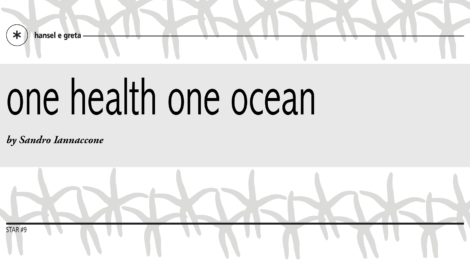
one health one ocean (eng)
The well-being and survival of the human species are linked to the well-being and survival of the sea, which is seriously endangered by climate change and pollution.
“Thálassa, Thálassa!”, meaning “Sea, sea!” This is what Xenophon shouted to his soldiers when, after an exhausting march, they finally reached the coast of the Black Sea. A similar impulse – though for less warlike purposes – would perhaps be needed today, two and a half millennia after that Anabasis, to remind us that we should take care of the sea because the sea is life, and without the sea, life could not exist.
The health and well-being of all living species are connected to the sea – and water in general. This idea forms the basis of the principles of One Health and Planetary Health, which state that human health is inseparable from the state of natural resources and environmental variables on which health depends.
Furthermore, the health and well-being of all living species are closely linked to the sea – and water in general. Science is well aware of this: it is one of the fundamental principles of One Health and Planetary Health, as the names suggest, emphasizing that human health is inseparable from the state of natural resources and environmental variables that influence health. This concept is so crucial that it has become part of the United Nations’ agenda. Together with FAO, OIE, and WHO, they have created a sort of guidebook for a global One Health approach, with six key points to pursue. Three of these objectives – the protection of nature, the availability of clean water, and the phasing out of incentives for fossil fuels – directly or indirectly concern the seas and oceans.
The oceans act as enormous “reservoirs” and heat exchangers. They tend to “store” excess heat, only to gradually release it into the atmosphere, thus increasing the planet’s temperature and starting the cycle again.
Despite these efforts, the outlook is not very optimistic: the health of the sea and the organisms that inhabit it is progressively deteriorating, and humans are mostly to blame. Pollution and climate change, in various ways, endanger our planet’s waters. These factors are triggering a vicious circle that is challenging to break. The oceans act as enormous “reservoirs” and heat exchangers, often referred to as the “buffer effect.” They tend to “store” excess heat for a certain period and within a certain threshold, only to gradually release it into the atmosphere, thus increasing the planet’s temperature and starting the cycle again. Let’s consider some numbers: almost all the water on Earth (the so-called hydrosphere) is contained in the seas and oceans (which make up 97% of it, to be precise), covering about three-quarters of our planet’s surface. The remaining 3% – freshwater – is mainly found in glaciers, permanent snow, and underground aquifers. What is happening to all this water? Unfortunately, not something good. The first and most worrying symptom is the temperature: according to two independent reports published by NASA-National Oceanic and Atmospheric Administration (NOAA) and the Copernicus Climate Change Service at the beginning of 2023, the last eight years have been the hottest ever recorded on our planet. Just like a gigantic sponge, the sea has absorbed about 90% of all this excess heat.
It is estimated that the average water temperature has increased by about 0.1°C per decade over the past forty years.
Thankfully, if it hadn’t been for this absorption, the atmospheric temperature would be about 33°C warmer today, rendering our planet uninhabitable for many of the species that currently inhabit it, including humans. By absorbing heat, the oceans have warmed up; it is estimated that the average water temperature has increased by about 0.1°C per decade over the past forty years. One-tenth of a degree may seem insignificant, but it is not. It is a significant and sudden change that has visible impacts in terms of the retreat of polar ice caps (for instance, last March, an iceberg the size of London broke off from an Antarctic ice shelf), rising sea levels (which have increased by about 20 centimeters since 1880 and continue to rise at a rate of just over three millimeters per year), the disappearance of coral reefs (the Intergovernmental Panel on Climate Change, IPCC, one of the most important climate-related institutions, has recently warned that if we don’t manage to keep the global average temperature increase below 2°C, over 99% of coral reefs will disappear), the migration of tropical fish colonizing temperate areas, coastal flooding, and increasingly violent cyclones.
The oceans also absorb carbon dioxide, which transforms into carbonic acid and lowers the water’s pH, jeopardizing the survival of many organisms.
The diagnosis doesn’t end here: besides heat, the oceans are also absorbing carbon dioxide (approximately one-third of that produced by anthropogenic emissions, as estimated), making the water increasingly acidic. In particular, carbon dioxide transforms into carbonic acid and lowers the water’s pH, jeopardizing the survival of many organisms at the base of the food chain (mollusks, crustaceans, corals, krill, and planktonic microalgae), and consequently affecting larger animals that depend on them. Since the industrial revolution, especially due to carbon dioxide emissions from fossil fuels (which is why earlier we highlighted among others, the United Nations’ objective to phase out incentives for fossil fuel exploitation), the acidity of seawater has increased by approximately 26%, at a rate a hundred times faster than natural variations that occurred in the last 55 million years.
It’s time to take action. Moreover, due to their higher temperature, marine waters are becoming increasingly depleted of oxygen (with 2% less since the mid-twentieth century, equivalent to about 77 billion tonnes, and the loss could double by the end of the century). Overfishing and unsustainable fishing practices (which affect up to 62% of the entire sector in the Mediterranean) are decimating the populations of many fish species because the fish do not have time to reproduce. Plastic and its fragments (the infamous micro and nano plastics) are now so abundant in the oceans (approximately 13 million tonnes of plastic end up in the oceans each year) that they cause enormous damage to ecosystems and even generate new ones, moving up the food chain and eventually affecting humans. It’s time to take action.
Sandro Iannaccone, physicist and journalist. He teaches scientific journalism at the masters “Science in journalistic practice” of the Sapienza University of Rome

















Commenti recenti